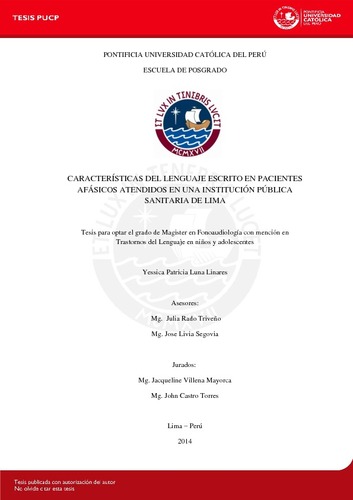| dc.contributor.advisor | Rado Triveño, Julia | |
| dc.contributor.advisor | Livia Segovia, José | |
| dc.contributor.author | Luna Linares, Yessica Patricia | es_ES |
| dc.date.accessioned | 2015-11-23T22:11:09Z | es_ES |
| dc.date.available | 2015-11-23T22:11:09Z | es_ES |
| dc.date.created | 2014 | es_ES |
| dc.date.issued | 2015-11-23 | es_ES |
| dc.identifier.uri | http://hdl.handle.net/20.500.12404/6422 | |
| dc.description.abstract | La presente investigación tiene como objetivo describir y comparar las características del lenguaje escrito entre pacientes afásicos fluentes y no fluentes. Para tales fines, se consideró, previa evaluación neurológica y diagnóstico de afasia, a 12 pacientes de una Institución Pública Sanitaria de la ciudad de Lima, quienes cumplieron además con los criterios tanto de inclusión como exclusión. De este modo la muestra fue conformada por ocho varones y cuatro mujeres, divididos en dos grupos: seis afásicos fluente y seis afásicos no fluentes. Se aplicó la subprueba de escritura del Test de Boston.
Los resultados indican que no existen diferencias estadísticamente significativas en las características de la escritura entre ambos grupos de pacientes afásicos. Sin embargo el análisis cualitativo evidenció una mejor ejecución del grupo de pacientes fluentes en las tareas de formulación escrita (escritura narrativa y oraciones escritas al dictado).
Por tanto se concluye que ambos grupos de pacientes afásicos presentan alteraciones no solo en el lenguaje oral sino también notorias alteraciones en su lenguaje escrito, proporcionando información relevante para la adecuada elaboración de programas de rehabilitación del lenguaje escrito. | es_ES |
| dc.description.abstract | This research’s objective is to compare the written language of fluent and non-fluent aphasic patients. For this end, with a previous neurological evaluation and a positive diagnosis of aphasia, 12 patients of a Public Health Institution in Lima, capital of Perú, were chosen. These met the criteria to be included in the research, and thus the crowd was composed of eight males and four females, which were divided into two groups: six people with fluent aphasia and six with non-fluent aphasia. The Boston Test’s writing subtest was applied, and the results show that there are no statistically-significant differences between written language in both groups. However, the qualitative exam indicated a better performance of the fluent patients in written tasks (narrative writing and written sentences from dictation).
As such, it was concluded that both groups of aphasic patients present notorious alterations on both oral language and written language, providing relevant information for adequate elaboration of rehabilitation programs for written language. | es_ES |
| dc.language.iso | spa | es_ES |
| dc.publisher | Pontificia Universidad Católica del Perú | es_ES |
| dc.rights | info:eu-repo/semantics/openAccess | es_ES |
| dc.rights.uri | https://creativecommons.org/licenses/by-nc/2.5/pe/ | * |
| dc.subject | Afasia | es_ES |
| dc.subject | Trastornos del habla | es_ES |
| dc.title | Características del lenguaje escrito en pacientes afásicos atendidos en una institución pública sanitaria de Lima | es_ES |
| dc.type | info:eu-repo/semantics/masterThesis | es_ES |
| thesis.degree.name | Maestro en Fonoaudiología con mención en Trastornos del Lenguaje en Niños y Adolescentes. | es_ES |
| thesis.degree.level | Maestría | es_ES |
| thesis.degree.grantor | Pontificia Universidad Católica del Perú. Escuela de Posgrado | es_ES |
| thesis.degree.discipline | Fonoaudiología con mención en Trastornos del Lenguaje en Niños y Adolescentes | es_ES |
| renati.discipline | 916137 | es_ES |
| renati.level | https://purl.org/pe-repo/renati/level#maestro | es_ES |
| renati.type | http://purl.org/pe-repo/renati/type#tesis | es_ES |
| dc.publisher.country | PE | es_ES |
| dc.subject.ocde | https://purl.org/pe-repo/ocde/ford#3.05.03 | es_ES |






